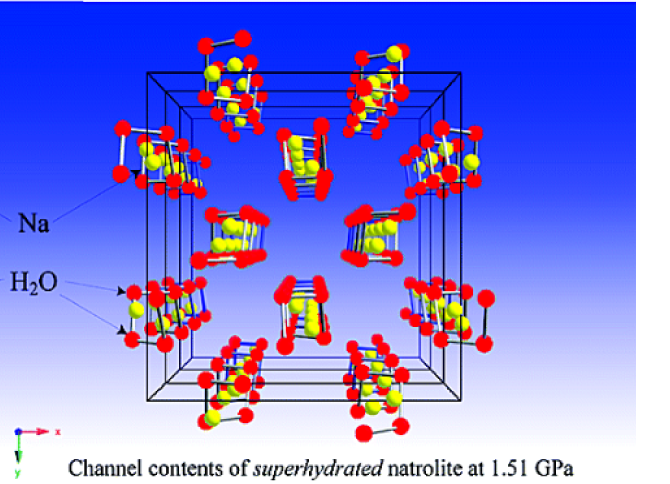"Pressure-induced volume expansion of zeolites in the natrolite family"
- Authors
Y. Lee, T. Vogt, J.A.Hriljac, J.B. Parise, G. Artioli
- Journal
Journal of the American Chemical Society
Vol.124, No.19, pp.5466-5475, 2002.05 - DOI
Abstract
Powder diffraction patterns of the zeolites natrolite (Na16Al16Si24O80·16H2O), mesolite (Na5.33Ca5.33Al16Si24O80·21.33H2O), scolecite (Ca8Al16Si24O80·24H2O), and a gallosilicate analogue of natrolite (K16Ga16Si24O80·12H2O), all crystallizing with a natrolite framework topology, were measured as a function of pressure up to 5.0 GPa with use of a diamond-anvil cell and a 200 μm focused monochromatic synchrotron X-ray beam. Under the hydrostatic conditions mediated by an alcohol and water mixture, all these materials showed an abrupt volume expansion (ca. 2.5% in natrolite) between 0.8 and 1.5 GPa without altering the framework topology. Rietveld refinements using the data collected on natrolite show that the anomalous swelling is due to the selective sorption of water from the pressure-transmission fluid expanding the channels along the a- and b-unit cell axes. This gives rise to a “superhydrated” phase of natrolite with an approximate formula of Na16Al16Si24O80·32H2O, which contains hydrogen-bonded helical water nanotubes along the channels. In mesolite, which at ambient pressure is composed of ordered layers of sodium- and calcium-containing channels in a 1:2 ratio along the b-axis, this anomalous swelling is accompanied by a loss of the superlattice reflections (bmesolite = 3bnatrolite). This suggests a pressure-induced order−disorder transition involving the motions of sodium and calcium cations either through cross-channel diffusion or within the respective channels. The powder diffraction data of scolecite, a monoclinic analogue of natrolite where all sodium cations are substituted by calcium and water molecules, reveal a reversible pressure-induced partial amorphization under hydrostatic conditions. Unlike the 2-dimensional swelling observed in natrolite and mesolite, the volume expansion of the potassium gallosilicate natrolite is 3-dimensional and includes the lengthening of the channel axis. In addition, the expanded phase, stable at high pressure, is retained at ambient conditions after pressure is released. The unprecedented and intriguing high-pressure crystal chemistry of zeolites with the natrolite framework topology is discussed here relating the different types of volume expansion to superhydration.












